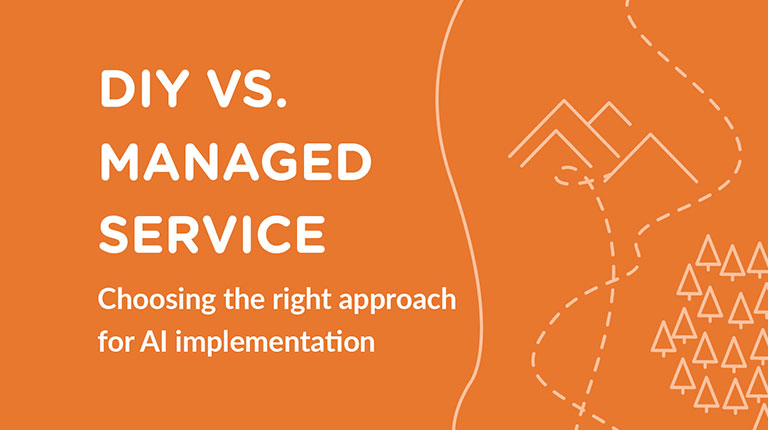At the beginning of the summer, we purchased a small do-it-yourself pool for our backyard. The set-up was easy enough. We simply had to piece together the frame, hook up the liner, and pop-it up. We filled it with water, installed the pump, and blew up our pool floats. We were about to enjoy the fruits of our labor when I asked my husband what chemicals we needed to keep the water clean and safe for swimming for the season. His response? A blank look.
When we initially thought about getting the pool, our main focus was on the set-up. Did we have a level spot in our yard? Would we be able to install it with just the two of us or would we need to ask a friend for help? We were so focused on getting things up and running, that we neglected to think beyond the set-up, and about what we would need to do (or what supplies to buy) to maintain the pool throughout the summer.
Today many brands are looking to improve customer experience and accelerate digital transformation by implementing Conversational AI applications–especially to support self-service in the area of customer care. And, consumers are open to using this type of automation and recognize the benefits. In fact, in a recent survey by Interactions, consumers cited the top benefits of using automated systems in customer care as “being able to take care of tasks when they want to” (45%) and the “speed of getting things done” (23%).
Businesses who are looking to implement these types of Conversational AI applications, have different choices on how to proceed–and their choices can lead to very different results. There are vendors who build and implement these applications. There are vendors who build, implement, and offer a managed service for the lifetime of the application. And, there are DIY applications that provide the tools for businesses to build their own application in-house.
Oftentimes, the DIY application looks great on paper. And for many businesses using internal resources, keeping innovation in-house, and driving costs down are major factors. Although implementing a Conversational AI application to support customer experience is much different than my pop-up pool, there are a few lessons to be learned when it comes to “doing it yourself” for both the short-term build through the long-term maintenance of the application.
So what makes a managed service a better choice when implementing Conversational AI especially when it involves customer experience? Here are the top three reasons why you should leave it to the experts.
“Set it and forget it” simply doesn’t work
This may have worked for Ron “Ronco” Popeil, one of America’s most celebrated inventors, when he promoted his rotisserie chicken invention, but Conversational AI is well…a different kind of bird. Typical “set it and forget it” deployment approaches simply don’t work since AI systems need constant training and tuning. Conversational AI applications require continuous improvement of conversation flows because as the consumer learns they can speak naturally, they will begin to speak in more free flowing terms, and the AI solution needs to be able to respond appropriately. This requires expertise and resources that are needed long after implementation won’t come with a DIY package. With a managed service, you can rest assured that the tuning and maintenance of your application will be taken care of by experts in this area and result in continuous improvement in your CX without you having to worry about it.
Clunky and robotic won’t keep customers
There’s a lot that goes into building a Conversational AI application to make it feel natural and human-like. To ensure this type of experience, designers with dialogue expertise are an essential element for success. These UI designers are experts in building call flows, grammar and brand persona development, usability, caller experience optimization, and speech integration. They have specific expertise in AI for customer experience. If they are not part of the equation, your application will be clunky and robotic–not something that will keep customers coming back. Working with a vendor who offers a managed service will give you access to this type of expertise and will help ensure that your application not only represents your brand but delivers the type of experience that keeps customers loyal.
You need expertise in both CX and industries
DIY solutions might sound like a good alternative, but businesses need to realize that building an application for customer care that also results in improved CX, requires a certain level of domain knowledge about the contact center and the customer experience industry. Fundamental knowledge of customer communication and requirements are necessary for success. A managed service not only provides expertise in these areas, but can also bring industry knowledge that is helpful in identifying industry-specific transactions to automate. And, with a managed service, businesses are paired with a customer success organization that works with the business to constantly identify areas of improvement. They also ensure the applications support the business as its goals evolve and change. With DIY, as with my pool, businesses are on their own to wade through the waters to figure things out on their own.
DIY vs Managed: How to make the decision?
In the end, businesses need to think about the CX they want to deliver. Yes, a DIY approach might seem like a good choice, but does your internal team have the expertise in both AI and CX to support an application from the start and throughout its lifetime as your business goals evolve? Without the expertise of a vendor who offers a managed service and who is always looking out for the best interest of you and your customers, your CX could fall flat which can greatly affect your customer loyalty and bottom line.





